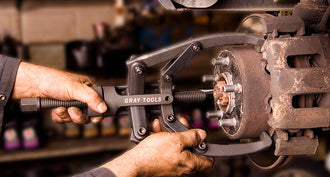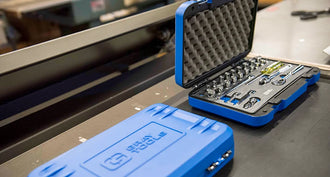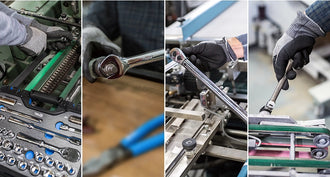Eye Bolts 101: How to Safely Select and Use the Right Eye Bolt For Your Application
- Gray Tools Official Blog
- 11 Jun, 2018

Selecting the right tool for the job can make a huge difference in productivity and quality of work. There are certain tools whose proper selection and use go beyond making your job faster and easier and actually affect workplace safety.
Eye bolts are such tools. For this reason, selecting and using eye bolts correctly can make the difference between a safe work environment and one that puts people’s lives at risk.
What Are Eye Bolts?
One of the most commonly used pieces of hardware in material handling, an eye bolt has a simple design, consisting of a threaded shank with a ring/eye at one end. Eye bolts are threaded to structures such as wood or steel posts and often supported by a nut. They are designed to have a rope or cable fed through the ring in order to lift objects.
The ring can be drop forged (one single piece, the eye being entirely closed) or bent to form a loop. Bent eye bolts should only be used in light duty applications and should never be used to execute angular lifts.
Eye bolts are available in two forms: rated and unrated. Rated eye bolts have been independently laboratory certified to ensure with performance and mechanical property compliance against a governing standard such as ASME and ASTM. Rated eye bolts provide users with peace of mind that quality and stated rated lifting capacities are as assured as possible.
Unrated eyebolts are, as the name implies, tools that have NOT been tested to ensure compliance against any governing standards. These eyebolts are generally less expensive and ideal for use in low load applications.
Types and Styles of Eye Bolts
The most common types of eye bolts used in industrial applications are: nut eye bolts, machinery eye bolts and screw eye bolts. All three types come in two styles: plain and shoulder. Each type comes in different sizes and finishes.

A regular nut eye bolt, also known as a plain pattern eye bolt, should not be used when applying angular loads as this procedure can bend or break them.
A shoulder nut eye bolt can be used when applying angular loads, while keeping in mind the rated capacity is drastically reduced when loading at any angle. When a shoulder pattern-lifting eye is properly seated in the receiving hole, the shoulder bears against the seat and reduces bending stress on the shank.
In theory, plain pattern and shoulder pattern-lifting eyes are equally suitable for vertical lifts. However, since there is no guarantee that a load will never be subjected to an angular lift; shoulder pattern lifting eyes are recommended for use wherever possible.
An angular lift places additional stresses on a lifting eye, above that of the load to be hoisted. For this reason angular lifts should be avoided whenever possible.
If, however, the situation necessitates an angular lift, a properly selected and inserted lifting eye must be used, and a reduction in the rated capacity must be applied. For information on how to compute these reduced rated capacities, consult the lifting eye bolt manufacturer.
A lag eye bolt features a screw thread and is used for threading into wood or lag anchors.
A machinery eye bolt does is not secured with a nut; instead it is designed to be installed into tapped holes. The minimum depth of the tap is obtained with the following formula:
Minimum tap depth = basic shank length + half the nominal eyebolt diameter.
Eye Bolt Materials
Eye bolts are made of various materials; the most common being carbon, stainless and alloy steel.
Stainless steel eye bolts are essentially rust proof, due to steel composition that includes iron, chromium, manganese, silicon, nickel, molybdenum, and only very small amounts of carbon.
For this reason stainless steel eye bolts will endure longer in marine applications. Moreover, the smooth appearance makes this type of eye bolt suitable in architectural applications, and a popular choice in pharmaceutical and food processing industries, due to lack of peeling and flaking.
Alloy steel eye bolts are ideal for cold weather applications. Lifting projects occurring in temperatures below -1°C (30.2° F) should be completed using an alloy steel eye bolt. The metallurgical properties of the alloy steel allows to maintenance of the structural integrity and performance even in cold environments.
Galvanized steel eye bolts are created by dipping standard carbon steel into molten zinc by a process called hot dipping, which results in an additional layer that protects against corrosion. For this reason, galvanized eye bolts are ideal for outdoor application as they are further resistant to the elements. However, the finish on the galvanized eye bolts is rough and can flake or peel; for a superior finish choose stainless steel eye bolts.
Eye Bolt Markings
Since eye bolts play an important role in the overall workplace safety chain, paying close attention and understanding various markings and specifications listed under each size is of paramount importance.
The image below shows the common ones you may come across in manufacturer’s catalogues or at the point of sale:

• Shank diameter (thread) is typically forged or permanently stamped on the eye, and gives you the size of the eye bolt. (A)
• Forge code marking allow eye bolt traceability to raw material
• Interior eye diameter (C)
• Exterior eye diameter (D)
• Overall length (E)
• Overall weight
• Rated Capacity-the rated capacity refers to the load a single eye bolt can lift when the load is applied through the shank of the eye bolt.
Quality Checklist
Below are important elements you should take into account before buying eye bolts for next project:
• Is it made from bar quality fine grain C1030 / C1035 steel bar
• Has it been normalized prior to machining
• Has it been proof tested in accordance with ASTM A489 and Federal Spec. ANSI B18.15
• Is ASTM A489 test data available from the manufacturer should you need it
Rated Capacity & Angular Lifts
As mentioned previously eye bolts are available in various sizes. The reason for this is to safely accommodate various loads/weights to be lifted.
The safe load of an eye bolt is designed to lift is called the Rated Capacity or Rated Working Load. Rated capacity refers to the load a single eye bolt can lift when the load is applied through the shank of the eye bolt.
A standard lift applied through the shank of the eye bolt is when the load is pulled completely vertically or perpendicular to the shank of the eye bolt. This type of list is also referred to as a 0° lift.
As soon as a lift begins to occur at any other angle, referred to as angular lift, the rated capacity of the eye bolt begins to diminish. The greater the angle the more drastically the rated capacity is reduced. The chart below shows the impact the direction of pull has on rated capacity:
Direction of Pull Rated Capacity
5 degrees 100% of rated working load
15 degrees 80% of rated working load
30 degrees 65% of rated working load
45 degrees 30% of rated working load
46+ degrees Not recommended
Additional tips and guidelines:
• Always use a shoulder eyebolt when performing angular lifts.
• Angular lifting using plain pattern eye bolts is not recommended.
• The marking on the eye bolts represent the thread size, not necessarily their rated capacities.
• Always check the manufacturer’s specification for rated capacity before conducting any lift.
• Angular lifts greater than 45° from the shank centreline is not recommended.
• When more than one eye bolt is used to lift an evenly distributed load the capacity is reduced on each eye bolt, based on the angle of the load.
Eye Bolt Installation and Maintenance
Just as important as choosing the correct eye bolt, properly installing and maintaining it is just as critical to ensuring workplace safety.
Installation Guidelines and Tips:
• The receiving hole should be counter-sunk and be free and clear of any debris to assure proper seating.
• Always inspect and clean the eye bolt threads and the hole before using.
• Loads should always be aligned to the plane of the eye, not at an angle to the plane. A steel washer or spacer may be used in conjunction with shoulder eye bolts to attain proper load alignment. The thickness of the steel washer or spacer must not exceed one thread pitch.
• Check seating after applying an angular lift since the initial lift may cause the bolt to back away from the load. If such occurs, the eye bolt should be unloaded and properly reseated.
• For applications with untapped through-holes, longer length shoulder eye bolts are recommended, using a steel washer and nut for the required thread length of engagement.
• Shoulder Eye bolt tapped holes are to have a threaded length, which allows for full length of shank engagement and clearance for the unthreaded portion of shank.
• Shoulder Eye bolts must be firmly seated and flush against the mating surface; otherwise, the rated capacity is reduced significantly. The use of a steel washer or spacer is permissible and may be required; however, the thickness must not exceed one thread pitch.
• Plain Eye bolt tapped holes are to be threaded for full-length engagement of the eye bolt.
• Plain Eye bolts must have full thread shank engagement, allowing for one-half turn for proper eye-alignment to obtain rated capacities.
• Orient the eye bolt in line with the slings. If the load is applied sideways the eye bolt may bend.
• Pack washers between the shoulder and the load surface to ensure that the eye bolt firmly contacts the surface. Ensure that the nut is properly torqued.
• Engage at least 90% of threads in receiving a hole when using shims or washers.
• Never attach more than one sling leg to an eye bolt.
• Always thread an eye bolt all the way down and ensure proper seating
• Ensure the tapped hole for a screw eye bolt (body bolts) has a minimum depth of one-and-a-half times the bolt diameter.
• Install the shoulder at right angles to the axis of the hole. The shoulder should be in full contact with the surface of the object being lifted.
What should you avoid when using eye bolts?
• Never force a sling through an eye bolt.
• Never over tighten an eye bolt.
• Never paint or color code an eye bolt. Painting may cover up critical flaws.
• Never force hooks or other fittings into the eye; they must fit freely.
• Never shock load an eye bolt, lifting should be completely slowly and gradually.
• Never use a single eyebolt to lift a load that will rotate freely.
• Never used an eyebolt with signs of wear or any other flaw.
• Never insert a hook in an eye bolt, always use a shackle.
• Never exceed the rated capacity of an eye bolt.
• Never alter an eye bolt. Grinding, machining, stamping or altered it any anyway may compromise the strength and integrity of the eye bolt.
Inspection
The working environment, such as ambient temperature and humidity, outdoor elements, and wear and tear, affects eye bolts. A qualified person who is knowledgeable about their application and installation should be routinely inspecting eye bolts before each use and reuse.
Eye bolts should not be painted or otherwise coated when used for lifting; such coatings make it difficult to inspect for defects or wear indicators.
Lifting eyes should be routinely inspected for such conditions as:
• Elongated or bent eye section
• Elongated or bent shank
• Nicks and gouges
• Obvious wear
• Signs of having been ground, cut, heat, welded, repaired or modified in any way
• Worn, corroded and/or distorted threads
• Cracks found by non-destructive testing
• Absence of sufficient identifying markings
If any of these conditions above exist, the lifting eye bolt should be removed from service and destroyed. Also, any eye bolt should be removed from service and destroyed when the manufacturer's identifying marks are no longer readily identifiable to guarantee proper reference for continued safe usage.
Crushing or cutting across the eye is a recommended method of destruction.
Eyebolts in Cold Weather Applications
Some applications require lifting loads in cold working environments. When working with eye bolts cold weather can be defined as a working condition below -1°C.
As described in part I in this series there are various governing standards that apply to eye bolts. The ASME (American Society of Mechanical Engineers) describes how to safely use various products.
There are three standards within ASME that apply to eye bolts: ASME B18.15 for imperial threaded eye bolts, ASME B18.15M for metric threaded eye bolts and ASME B30.26 for Rigging Hardware of which eye bolts are a part of the adjustable hardware section.
ASTM is a standards body that determines material requirements and establishes testing protocols to ensure compliance with ASME standards. The two testing standards that apply are ASTM A489 for Carbon Steel Lifting Eyes and ASTM F541-12 Standard Specification for Alloy Steel Eye bolts.
The ASME B30.26 standard is applicable only to carbon steel eye bolts specifies that carbon steel eye bolts are only to be used above -1°C. For environments below -1°C the standard is ASTM F541-12. In order to achieve certification with this standard the eye bolt must be made of alloy steel and be permanently marked with the letter A denoting it as cold weather specific.
Therefore, there is no situation in which a carbon steel eye bolt can be certified for safe use below -1°C. If any doubt exists regarding the possible lowest working temperature a rated alloy steel eye bolt should be used.




Thank you for this article. They should repost this to engineering toolbox. Great critical information.
Very informative.
Thank you